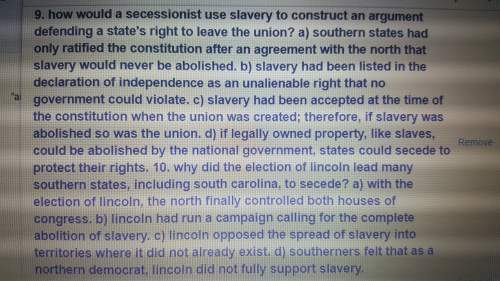
History, 12.12.2019 09:31 evan1v1123
Iforgot to study : ( 60 points and brainliest answer for answering these questions! answer as many questions correctly as possible!
1. how did the cotton gin affect both small upcountry farmers and large lowcountry farmers?
a) it destroyed business for the upcountry farmers who could not afford the new invention, and created a larger profit for the lowcountry farmers.
b) it decreased reliance on the plantation system in the south, and the cotton gin led to a growth of cities and industry in the lowcountry of south carolina.
c) upcountry farmers could now compete with those in the lowcountry, as it led to a decrease in the number of slaves needed to run a successful plantation.
d) it allowed upcountry farmers to obtain wealth and status through cotton and slaves, leading to more similar interests between the two regions.
2. what effect did the denmark vesey plot have on sectionalism in the united states?
a) laws were enacted in the aftermath of the plot to make it harder to free slaves, increasing sectionalism.
b) once the plot was discovered, tension concerning slave revolts eased, decreasing sectionalism.
c) laws were put in place to make slavery less oppressive and reduced the risk of rebellion, decreasing sectionalism.
d) the plot inspired whites in the area to slaves escape to freedom, increasing sectionalism within the south.
3. what was the primary motive of south carolinians in supporting the war of 1812?
a) they were concerned france was trying to reestablish a presence in north america.
b) they wanted to show unity with new england where support for the war was strong.
c) they were angered by repeated violations of spain regarding the freedom of the seas.
d) they believed that great britain had never really accepted america's independence.
4. how did the growth of the abolitionist movement lead to increased sectionalism in the united states?
a) the movement gained large support in the south, increasing the fears of large plantation owners.
b) when leaders in congress began to support the cause, pro-slavery supporters turned against the nation.
c) the growth of the movement threatened the plantation lifestyle and created a divide between the north and south.
d) the violence prompted by the movement created fear for people living in the south.
5. while at a banquet during his vice presidency, john c. calhoun gave a toast: "to the union. next to our liberty, most dear."
what does this quote reveal about why many south carolinians wanted to secede from the union?
a) some south carolinians threatened to secede if liberty was not extended to the enslaved.
b) south carolinians in support of secession believed liberty was more important than maintaining the union.
c) the south carolinians in support of secession wanted to leave the south and move to the north.
d) john c. calhoun encouraged many south carolinians to support the union, even if it meant the loss of liberty.
6. how did reactions to the passage of the kansas-nebraska act lead to south carolina's secession from the union?
a) after lobbying congress to reconsider the validity of popular sovereignty, south carolina decided to secede.
b) settlers split the state of kansas in two, a free state and a slave state, only temporarily preventing secession.
c) the violence between pro- and anti-slavery settlers prevented any compromise between the north and south, leading to secession.
d) south carolina was with the ultimate decision that both kansas and nebraska would be free, leading to secession.
7. which condition would a cooperationist insist be met for south carolina to choose secession?
a) secession would need to be allowed specifically in the constitution.
b) other southern states would also have to agree to secede.
c) a majority of voters in the state would have to approve secession.
d) the national government would first have to abolish slavery.
8. in what way would a secessionist defend the actions of south carolina as the state left the union?
a) since a republican was elected president, south carolina had no choice but to secede to protect its way of life.
b) as a part of the compromise of 1850, the constitution was amended to allow the states to secede from the union.
c) new england states had seriously considered secession during the war of 1812, so it was a valid action.
d) the political theory of popular sovereignty claimed that the people of a state had a right to vote for secession.


Answers: 3
Another question on History

History, 21.06.2019 15:30
How did the economy in the 20’s lead to the florida land boom.
Answers: 1

History, 21.06.2019 20:10
Which best describes the characteristics of lynchings in the south from 1880 to 1910? a. the number of lynchings in the south increased b. the number of lynchings in the south decreased. c. the number of lynchings in the south stayed the same. od. the number of lynchings in the south equaled the number in the north
Answers: 3

History, 21.06.2019 20:10
Which nonverbal cue most likely indicates that a person is open to a conversation? lack of eye contact crossed arms smiling mouth o monotone voice
Answers: 2

History, 22.06.2019 01:00
Aperson who makes maps is called a mapper drawer cartographer
Answers: 1
You know the right answer?
Iforgot to study : ( 60 points and brainliest answer for answering these questions! answer as many...
Questions


Mathematics, 11.10.2021 07:10

Geography, 11.10.2021 07:10



Mathematics, 11.10.2021 07:10

Computers and Technology, 11.10.2021 07:10

Social Studies, 11.10.2021 07:10

History, 11.10.2021 07:10


Business, 11.10.2021 07:10

Mathematics, 11.10.2021 07:10

History, 11.10.2021 07:10

Mathematics, 11.10.2021 07:10

Mathematics, 11.10.2021 07:10

Computers and Technology, 11.10.2021 07:10

Mathematics, 11.10.2021 07:10



Chemistry, 11.10.2021 07:10



